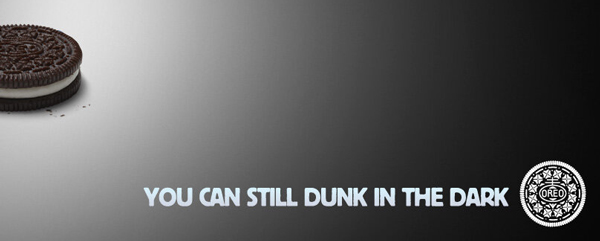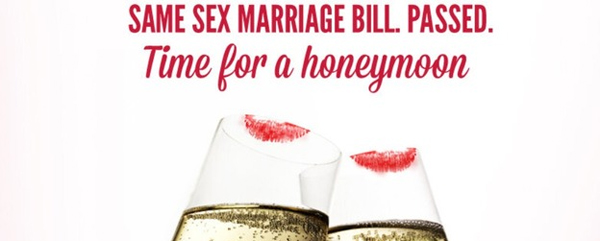This post originally appeared in our February Issue of “Live Report from the Future of Marketing,” our monthly Post-Advertising newsletter. Subscribe for free here.
The blanket of snow that fell across the UK a few weeks ago reminded me of one of my favourite marketing campaigns in recent years. If you haven’t seen this fantastic piece of opportunistic advertising before, the Polo Snow Stamp was pressed into thick snow on cars, park benches and roads across London, creating a perfect replica of the iconic white mint with the hole.
What impressed me most then and still impresses me now is that whilst the rest of the country perceived the onset of snow as the perfect excuse for a day off from work, Polo’s agency was looking at the weather reports and seeing only opportunity. Smart planning and a quick response to circumstances beyond its control (in this case physical) created some fantastic earned media. Now, three years later, people who saw the campaign are reminded of Polo every time snow falls.
Over the past month, I’ve noticed other brands adopting the same tactics time and again with great success. No brand can wait for that one-day window when it snows in England for an opportunity, so instead the white canvas of snow and mint replica have been replaced with social media platforms and seminal events that tap into the buzz in those communities. Those that do it well join the conversation and experience the moment with their audience.
1. Oreo’s Dunk in the Dark

The winner of the #BrandBowl 2013 has had enough praise since Super Bowl XLVII that everything that could be said has been, but it’s so brilliant that it’s worth revisiting. The creation of a Super Bowl command centre hosted at the offices of agency 360i, with representatives of several of Oreo’s agencies as well as the brand, meant that even though no one knew the lights were going to go out in New Orleans, Oreo was the brand in the best position to react to even the most unpredictable events.
The other side of this ad, which has been overlooked amongst all the compliments, is why an ad with such simple copy and unexceptional visual imagery managed to resonate so exceptionally well with audiences on social media (our own Jon Thomas has a strong opinion about it). It is my belief that the fundamental reason relates to something that is at the heart of everything we do here at Story Worldwide: connecting brands to their audiences with engaging and entertaining stories that audiences actually want to hear.
As the lights went out in New Orleans and confusion enveloped the hundreds of millions of observers around the world, people took to their trusted social channels for more information. As friends checked Twitter and Facebook, amongst the jokes about the imminent arrival of Bane or the Undertaker, Oreo was there, sharing the moment with its audience and in a tone of voice true to the brand. No one will forget the great Super Bowl Blackout, and Oreo will forever be a part of it by having placed itself in the conversation with its audience.
2. Specsavers

In discussing brands reacting in real time to events, our CEO, Kirk Cheyfitz, observed that ‘we all know social media is a real-time sport, not to be attempted by those who can’t work weekends or nights’. An obvious statement, but no brand has epitomised this always-on, reactive approach better than the UK high-street optician Specsavers.
The tactic of responding to sporting mishaps began at last summer’s European Championship. Once again a game involving the English national football team boiled down to a decision on whether the ball had or hadn’t crossed the goal line, though replays showed it had. The next day, Specsavers posted an ad taunting the official for his decision in a number of the UK newspapers. The strapline ‘Should’ve gone to Specsavers’ is so deeply etched in popular culture that the audience knew exactly what was being said even when it was written in Ukrainian.
After the success of its Ukraine press ad, Specsavers was quick to react again to sporting stories. When the South Korean flag was flown during the North Korean national anthem at last summer’s Olympics, and last month after Chelsea player Eden Hazard was accused of kicking a ball boy, Specsavers utilised its Twitter account to post similar ads.
3. Virgin Holidays

Of the three examples given here, no brand has been truer to the audience it is attempting to reach or its brand persona than Virgin Holidays. Instantly recognisable and personified by its eccentric founder, Richard Branson, Virgin is renowned for fighting the established force in whatever market it chooses to diversify into next. For example, if it comes up against British Airways, the flag carrier for Britain, which represents the choice of airline for the conformist, Virgin Atlantic offers the sexier and younger option.
When a historic bill granting same-sex couples the right to marry was passed by the UK government, Virgin was uniquely positioned to genuinely engage through a picture of two lipstick-marked champagne flutes and the strapline ‘Time for a honeymoon’. If the same strategy had been adopted by another brand to address this particular situation, that brand could have risked looking opportunistic for the wrong reasons.
Virgin’s excellence highlights again how vital the twin pillars of smart planning and quick response to external circumstances are to ensuring great real-time social media advertising. In this instance the smart planning guaranteed that the published ad spoke to the audience and brand in a genuine way, and it was delivered the moment the bill passed.
These three examples illustrate how powerful advertising can be when agencies and brands work in tandem to engage in real time with their audiences. The ads that are winning these moments are those that respond fast whilst staying true to the brand story and its audience. The brands that continue to tie up progress in review processes will continue to miss out on these opportunities and will see audiences going elsewhere.




Pingback: Real Time Advertising: Can Creative Professionals Thrive in It? «Ampersands and Erasers Ampersands and Erasers
Pingback: 3 Brands Winning the Real-Time Media Game « Marketing Research Tools
Pingback: 3 Brands Winning the Real-Time Media Game | Marketing News Alert